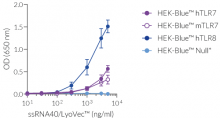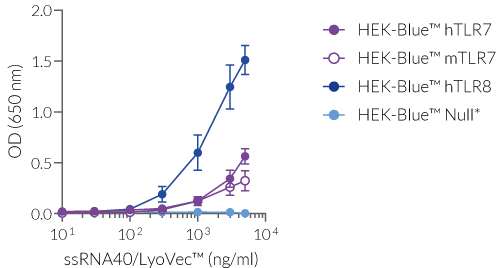ssRNA40/LyoVec™
| Product | Unit size | Cat. code | Docs. | Qty. | Price | |
|---|---|---|---|---|---|---|
|
ssRNA40 / LyoVec™ TLR7/8 Agonist - HIV-1 LTR-derived ssRNA / LyoVec™ |
Show product |
4 x 25 µg |
tlrl-lrna40
|
|

Activation of TLR7/8 by ssRNA40/LyoVec™
TLR7/8 Agonist - HIV-1-derived ssRNA - complexed with LyoVec™
ssRNA40 is a 20-mer phosphorothioate-protected single-stranded RNA oligonucleotide containing a GU-rich sequence. ssRNA40, also known as R-1075, is a U-rich single-stranded RNA derived from the long terminal repeat of HIV-1.
ssRNA derived from HIV-1 or the influenza virus were shown to induce the production of proinflammatory cytokines by activation of the Toll-like receptors TLR7 and/or TLR8.
Description
InvivoGen's ssRNA40/LyoVec™ is complexed with the cationic lipid LyoVec™ to protect it from degradation and facilitate its uptake. Moreover, phosphorothioate linkages were incorporated in order to extend the effective molecular lifetime by minimizing extra and intracellular nuclease degradation. ssRNA40/LyoVec™ is a weak TLR7 and strong TLR8 agonist, when tested using our HEK-Blue™ reporter cell lines expressing human or mouse TLR7 or TLR8 (see figure).
Key features of ssRNA40/LyoVec™
- Activator of TLR7 and TLR8
- Negative control ssRNA41/LyoVec™ is available
- Complexed with LyoVec™
- Each lot of ssRNA40/LyoVec™ is functionally tested
![]() Read our review about TLR7 and TLR8.
Read our review about TLR7 and TLR8.
Specifications
Specificity: human TLR8
Working Concentration: 0.25-5 μg/ml
Sequence: ssRNA40 5’-G*C*C*C*G*U*C*U*G*U*U*G*U*G*U*G*A*C*U*C-3’
(“*” depicts the phosphorothioate linkage)
Solubility: 0.05 mg/ml in water
Quality control:
- The biological activity of ssRNA40/LyoVec™ has been validated using cellular assays.
- The absence of bacterial contamination (e.g. lipoproteins and endotoxins) has been confirmed using HEK-Blue™ hTLR2 and HEK-Blue™ hTLR4 cells.
Contents
- 4x 25 μg lyophilized ssRNA40/LyoVec™ 1:2 ratio (w/w)
Note: Each vial contains 25 μg of ssRNA40 complexed with 50 μg LyoVec™.
- 10 ml endotoxin-free water
![]() ssRNA40/LyoVec™ is provided lyophilized and shipped at room temperature.
ssRNA40/LyoVec™ is provided lyophilized and shipped at room temperature.
![]() Store at -20 ̊C.
Store at -20 ̊C.
![]() Lyophilized product is stable 1 year at -20 ̊C.
Lyophilized product is stable 1 year at -20 ̊C.
Upon resuspension, store product at 4°C. Resuspended product is stable 1 week at 4°C.
Back to the topDetails
ssRNA40 is a 20-mer phosphothioate-protected single-stranded RNA oligonucleotide containing a GU-rich sequence [1].
ssRNA40 is complexed with the cationic lipid LyoVec™, to protect it from degradation and facilitate its uptake, and lyophilized to generate ssRNA40/LyoVec™. When complexed to cationic lipids, ssRNA can substitute for viral RNAs in inducing TNF-α and IFN-α production in peripheral blood mononuclear cells [1, 2].
Murine dendritic cells deficient for TLR7 failed to produce IFN-α in response to ssRNA40. In contrast, the response to CpG-ODNs was unaffected, suggesting that TLR7 plays a critical role in viral ssRNA recognition [1].
In human cells, TLR8 was shown to be the key receptor for viral ssRNA, implying a species specificity difference in ssRNA recognition.
During infection, some viral particles are degraded by the endosomal proteases, exposing the viral genome and allowing TLR7 and/or TLR8 signaling, known to occur in endosomes [3].
TLR7 and TLR8 can recognize both self and viral RNA but can distinguish the presence of viral RNA by detecting their abnormal localization in the endosome rather than a particular RNA motif.
1. Heil F. et al., 2004. Species-specific recognition of single-stranded RNA via toll-like receptor 7 and 8. Science. 5;303(5663):1526-9.
2. Diebold SS. et al., 2004. Innate antiviral responses by means of TLR7-mediated recognition of single-stranded RNA. Science. 5;303(5663):1529-31
3. Heil F. et al., 2003 The Toll-like receptor 7 (TLR7)-specific stimulus loxoribine uncovers a strong relationship within the TLR7, 8 and 9 subfamily. Eur J Immunol. 33(11):2987-97.






